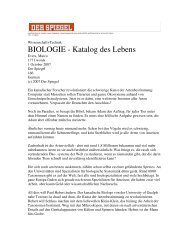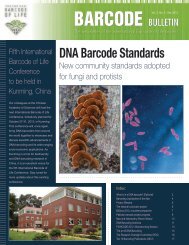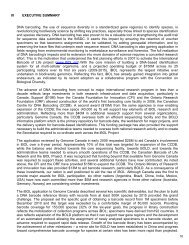Focus On DNA Barcoding - University of Guelph
Focus On DNA Barcoding - University of Guelph
Focus On DNA Barcoding - University of Guelph
You also want an ePaper? Increase the reach of your titles
YUMPU automatically turns print PDFs into web optimized ePapers that Google loves.
Raising the bar<br />
High-throughput facility boosts volume <strong>of</strong> species identified<br />
Canada’s <strong>DNA</strong> barcoding efforts have<br />
gained momentum with the newly opened<br />
Biodiversity Institute <strong>of</strong> <strong>On</strong>tario (BIO)<br />
facility at the <strong>University</strong> <strong>of</strong> <strong>Guelph</strong>.<br />
The new facility, a $4.2-million,<br />
15,000-square-foot building, opens<br />
opportunities for heightened research<br />
productivity. It will help fast track <strong>DNA</strong><br />
barcoding technology’s introduction to<br />
public use for applications such as border<br />
control or pest management.<br />
BIO is home to the Canadian Centre<br />
for <strong>DNA</strong> <strong>Barcoding</strong> (CCDB). This centre<br />
develops laboratory protocols and maintains<br />
the Barcode <strong>of</strong> Life Data System, an online<br />
data management system which is central to<br />
the global barcoding community for<br />
maintaining barcode records and being<br />
a resource to diagnose unknown animals.<br />
CCDB also serves as core facility and<br />
headquarters for researchers in the Canadian<br />
Barcode <strong>of</strong> Life Network, enabling them to<br />
gather and share ideas and information to<br />
advance <strong>DNA</strong> barcoding research.<br />
“Our location in BIO has allowed us to<br />
concentrate our resources to become a highthroughput<br />
facility for <strong>DNA</strong> barcode<br />
analysis and production,” says Alex Smith,<br />
BIO research program co-ordinator.<br />
In the past, <strong>DNA</strong> barcoding research<br />
was based out <strong>of</strong> a single laboratory at the<br />
<strong>University</strong> <strong>of</strong> <strong>Guelph</strong>. This location was<br />
capable <strong>of</strong> processing up to 75,000 samples<br />
for barcoding each year.<br />
But now, BIO’s launch dramatically<br />
raises that capacity. Heightened production<br />
in all aspects <strong>of</strong> barcode research and new<br />
equipment at the facility will result in an<br />
anticipated output <strong>of</strong> 500,000 barcode<br />
analyses per year. And improved efficiencies<br />
are expected to reduce barcoding costs in the<br />
new facility.<br />
“The productivity levels that we are now<br />
able to reach should help ensure that the<br />
global effort to barcode all animal species will<br />
continue to be based in <strong>Guelph</strong>,” says Smith.<br />
Funding for the BIO building and<br />
barcoding research is provided in part by<br />
Genome Canada through the <strong>On</strong>tario<br />
Genomics Institute. Additional funding for<br />
BIO comes from the Canada Foundation for<br />
Innovation and the <strong>On</strong>tario Innovation<br />
Trust. <strong>Barcoding</strong> research is sponsored<br />
through the Gordon and Betty Moore<br />
Foundation, the Natural Sciences and<br />
Engineering Research Council, the <strong>On</strong>tario<br />
Research Fund and various federal and<br />
private sector organizations. •<br />
Alex Smith, BIO research program co-ordinator (left), and biology<br />
pr<strong>of</strong>essor Bob Hanner say <strong>DNA</strong> barcoding technology is steadily<br />
progressing because <strong>of</strong> heightened research activity at <strong>Guelph</strong>.<br />
Funding for <strong>DNA</strong> <strong>Barcoding</strong><br />
at the <strong>University</strong> <strong>of</strong> <strong>Guelph</strong><br />
February 2007<br />
<strong>On</strong>tario<br />
Innovation<br />
Trust<br />
Canada Foundation<br />
for Innovation<br />
Natural<br />
Sciences and<br />
Engineering<br />
Research<br />
Council<br />
Gordon and Betty<br />
Moore Foundation<br />
Genome<br />
Canada<br />
Federal,<br />
provincial<br />
and other<br />
sources<br />
Canada Foundation<br />
for Innovation<br />
Federal, provincial<br />
and other sources<br />
Genome Canada<br />
Gordon and Betty<br />
Moore Foundation<br />
Natural Sciences and<br />
Engineering Research Council<br />
<strong>On</strong>tario Innovation Trust<br />
Total<br />
$5 million<br />
$2 million<br />
$5 million<br />
$3 million<br />
$5 million<br />
$5 million<br />
$25 million<br />
Research | <strong>Focus</strong> on <strong>DNA</strong> <strong>Barcoding</strong>








